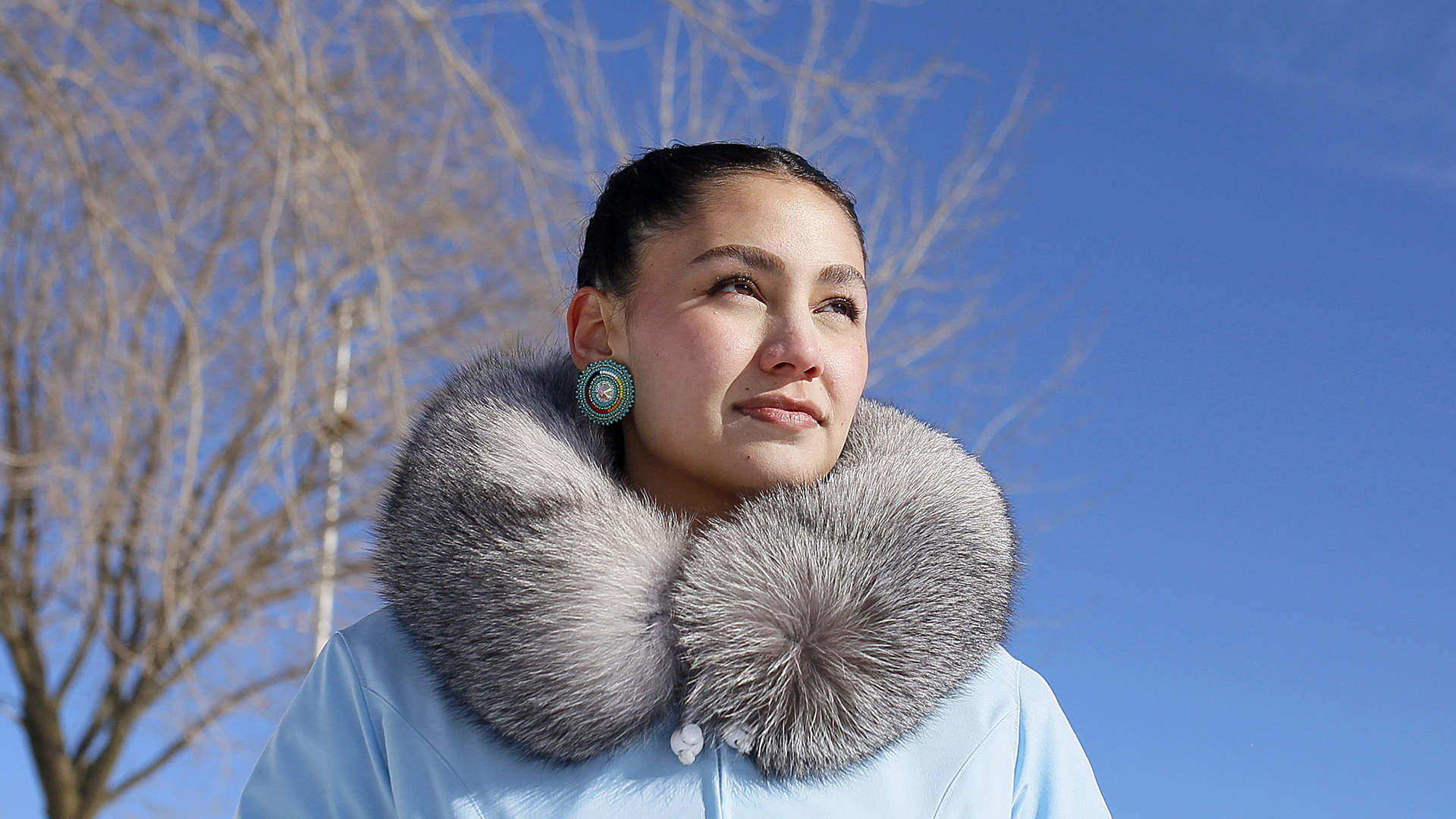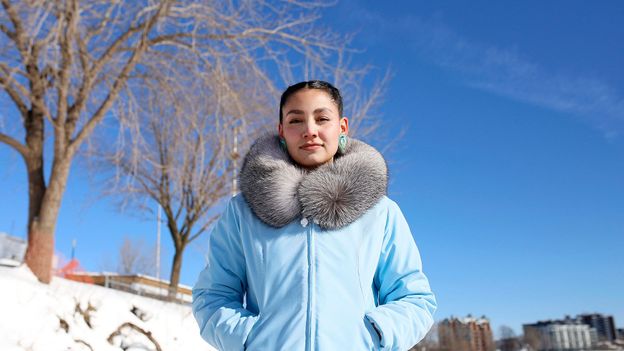BBC – Travel – A revival of Indigenous throat singing
Shina Novalinga locks eyes with her mother, Caroline, with an intimacy and closeness that feels that much more special during a pandemic. Caroline tilts to her other foot and exhales a guttural sound. Shina replicates and the two go back and forth, producing an infectious beat that’s hard to resist bobbing to.
50 Reasons to Love the World – 2021
Why do you love the world?

“Because of all of our differences. We each have our culture, our identity, our story… To me being different is beautiful and I embrace my Indigenous identity more and more everyday.” – Shina Novalinga, throat singer
Sometimes the pitch is high, sometimes it’s low, but it’s nearly impossible to decipher who is making which sound (“If you’re confused who’s making the noise that’s a good thing,” Shina explained later). Finally, the two burst into laughter and turn to smile for the camera.
Then, the likes and comments pour in.
Inuit throat singing was at risk of extinction after years of erasure by colonists and missionaries, but Shina, who was born in Nunavik and now lives in Montreal near the banks of the St Lawrence River, is sharing the tradition for a new generation. She’s posting videos to TikTok, a social media platform particularly known for song and dance, and at last count, she’s earned 1.9m followers along with more than 60m likes.
But what Shina is doing goes well beyond social media fame, according to Evie Mark, a throat singer and professor at Nunavik Sivunitsavut, a college programme for Inuit studies. “She’s making a statement to say, ‘I’m bringing back what was shamed upon.'”
I’m bringing back what was shamed upon
According to Inuit legend, the first throat singers weren’t Inuit or even human, but rather small birds with human-like features called Tunirtuaruit. “It was hard to see them because they were very shy or afraid of human people and they would live in abandoned snow houses, or homes, and often you would see families of them,” Mark said.
The human version of traditional Inuit throat singing involves two people, usually women, facing each other and using their throat, belly and diaphragm to expel sounds. The two participants go back and forth, matching their partner’s rhythm until one goes silent or starts laughing. “It’s a very intimate thing so for sure you’re going to be triggered to smile or laugh, especially when you start seeing the person’s eyes when you’re singing together,” Mark said.
Throat singing exists in other cultures as well, including khöömei, found in Mongolia, Siberia and in the Tuva region on the Russia-Mongolia border. Just like Inuit throat singing found in the Canadian Arctic, Greenland and Alaska, khöömei mimics the natural environment, such as animals, mountains and streams. But in khöömei, it is men who usually sing, while it’s women in Inuit culture.
“In our region, the men often had to go hunting either for two hours, two days, two weeks, two months and we are a matriarchal society only because the women were at home preparing clothing, food, garments and so on,” Mark explained, “I think that the women had more time on their hands to keep themselves entertained even though they were so busy sewing clothing and so on.”
Mark clarified there are some Inuit men who do a form of throat singing – they imitate animal sounds while they’re hunting and shamans chant. But women and children throat sang in the way we hear it today to keep their minds busy and their bodies warm during frigid weather. Throat singing was also a way to cope while social distancing during pandemics like the Spanish flu or measles. “Entertaining themselves – singing songs, telling stories – was crucial for them to find happiness,” Mark said. “This allowed my grandparents to keep warm and to focus on their breathing. Like we try to do today: we try to find some peace or solace during the pandemic.”
But in the early 20th Century, Christian missionaries in the Arctic shamed Inuit for throat singing. “What they were told is it’s bad, it’s Satanic. In fact, it wasn’t – it allowed them to flourish for thousands of years and all of a sudden, [they] couldn’t,” Mark said.
Throat singing nearly died out, but in Puvirnituq, a village on the coast of Hudson Bay 1,630km north of Montreal, an elder wanted to preserve it. He asked the community’s four remaining throat singers to pass their skills onto a new generation of women. One of these women was Caroline Novalinga, who later taught it to her daughter, Shina.
Growing up in Puvirnituq, Caroline recalls spending her summers camping, chasing geese in springtime and skating or watching the ice fishers in winter. She also loved to sew and throat sing. “We used to have so much to do when we were growing up,” she said.
Caroline moved to Montreal for college when Shina was four and shared her Inuit traditions with her daughter, including speaking Inuktitut at home. But it wasn’t until Shina was 17 that she finally decided to teach her to throat sing. “I had tears when she sang,” Caroline said. “I was so happy and emotional and proud, all those emotions.”
Along with preserving Inuit culture, throat singing has brought Caroline and Shina even closer. “We have this connection that is kind of unexplainable between mother and daughter and it gives me this zone of comfort when I throat sing with her,” Shina said.
But while Shina – who is half-Inuk and half-Quebecoise – has always been close with her mother, she felt out of place as a teenager in Montreal. “I was always proud of my heritage, but I didn’t show it as much. I was kind of more scared to show it,” she said. “I would dye my hair lighter… I feel like I had an identity crisis because I didn’t really know which group I fit in.”
You may also be interested in:
• The restaurateur who overcame Canada’s Sixties Scoop
• Why First Nations communities are uninviting visitors
• The chef preserving Canada’s Indigenous identity
While studying at John Abbott College, Shina had a First Peoples’ Voices teacher that encouraged her to learn more about her culture and traditions beyond what Caroline had taught her. “That’s when I realised how important it is and how much we’ve gone through, just for me to not embrace my identity? So that’s when things started changing in my head.”
In class, Shina learned about the injustices done to her people such as residential schools and the Sixties Scoop, where children were placed in non-Indigenous homes as a method of assimilation. For one class presentation, Shina throat sang. “I was still just learning. It was definitely this year and last year that everything changed,” she said.
In March 2020, when the first wave of the pandemic hit Montreal, Shina started sharing throat singing videos on TikTok. The videos also showcased the gorgeous handmade parkas sewn and designed by her mother along with facts about Indigenous history. “For me it’s so normal, but I realised how unique it is for everyone to hear that, and even just different aspects of our culture, our food, our clothing,” Shina said.
We have all these platforms to finally put our foot down and speak up about our beautiful culture and embrace it
Almost instantly, her videos started to rack up hundreds of thousands, even millions of views.
Shina said she was inspired by the Black Lives Matter movement to share her story as well as by her grandmother, a poet, who didn’t have the technology to reach as many people with her art. “It’s important to speak about the culture because my grandparents, older generations didn’t have the opportunity to speak up,” Shina said. “And now we have social media, we have all these platforms to finally put our foot down and speak up about our beautiful culture and embrace it.”
And the likes kept on rolling in. “Seeing so much positive feedback and having all this recognition, it just pushed us to keep going,” she added.
But Shina’s trepidations as a teenager about showing her Inuk side were realised when she started to receive negative comments on social media, especially about the clothes she was wearing. “People love what my mom makes, but as soon as they find out that it’s real fox fur some are like, ‘Oh, you’re cruel. Why would you do this? Don’t use real animal.'”
Shina tried to explain that traditional Inuit hunting has been sustainable for thousands of years, but many wouldn’t listen. “I used to be super defensive, and I would talk back to try to educate and explain, but I realised that I was only attracting those people,” she said. “It’s not wrong, but at the same time I wasn’t happy with myself, so I changed my content to be more positive and to ignore comments like that and to just keep showing the beauty of our culture instead.”
Still, Shina couldn’t resist fighting back. In a recent post, she’s seen crying over a video of two people mocking throat singing. “People misunderstand our way of life, our Inuit culture… but I go on social media to prove them wrong and to educate that we’re all on the same page,” she said. “I’m half Inuk and I’m half Quebecoise, I know both sides and I want to be the bridge to have this reconciliation.”
In 2014, throat singing was given cultural heritage status in Quebec – the first designation of its kind for something intangible (the distinction had previously been reserved for artefacts, architecture and photography). Throat singing has also been popularised in recent years thanks to artists like Tanya Tagaq, Quantum Tangle, Piqsiq and Riit.
Shina and Caroline (who has her own popular TikTok account) have recorded a throat singing album of their own and plan to release it later this year. “We want to show people that throat singing exists and we want to make sure that it stays for as long as we can,” Shina said.
As for social media and the negative comments it attracts, Shina plans to continue sharing positive content. She urges others – especially young Indigenous women like herself – to share their voices, too. “A lot of indigenous youth are afraid just like I was and it’s important to embrace who you are, your identity and not be ashamed of your culture,” she said.
BBC Travel celebrates 50 Reasons to Love the World in 2021, through the inspiration of well-known voices as well as unsung heroes in local communities around the globe.
—
Join more than three million BBC Travel fans by liking us on Facebook, or follow us on Twitter and Instagram.
If you liked this story, sign up for the weekly bbc.com features newsletter called “The Essential List”. A handpicked selection of stories from BBC Future, Culture, Worklife and Travel, delivered to your inbox every Friday.
www.bbc.com 2021-04-15 11:56:19



